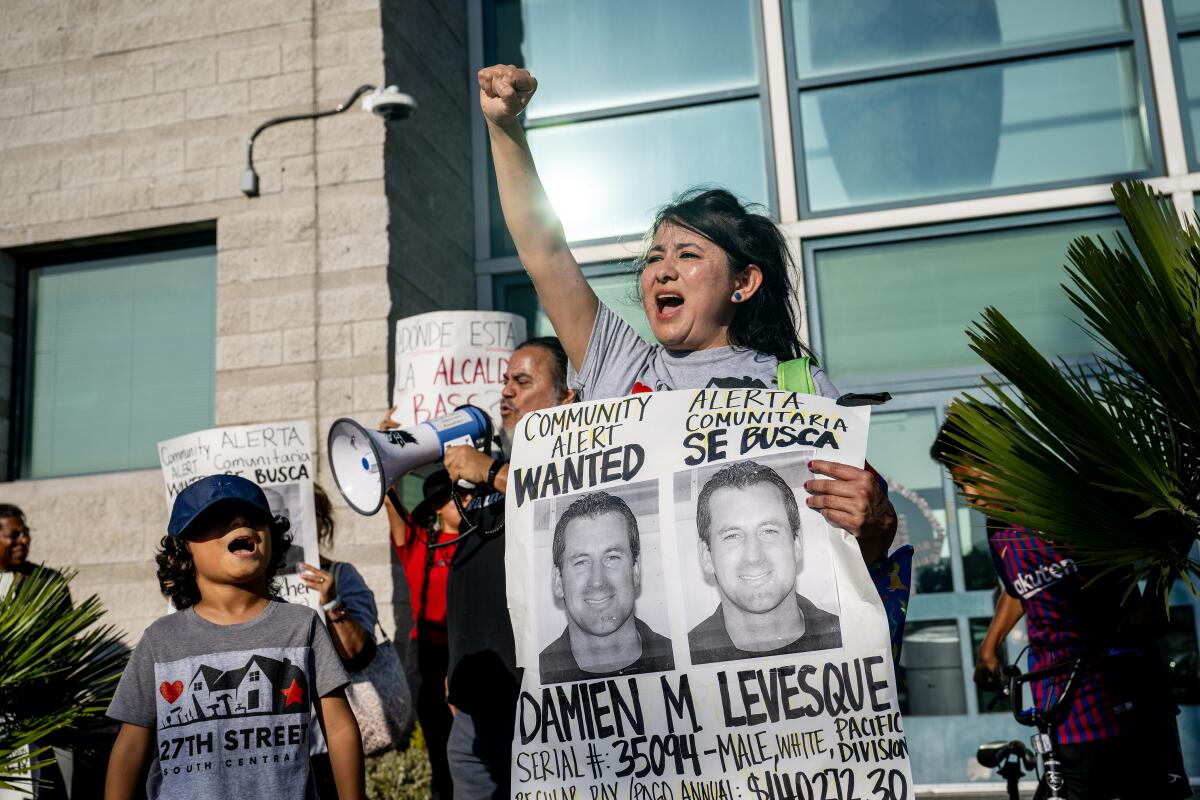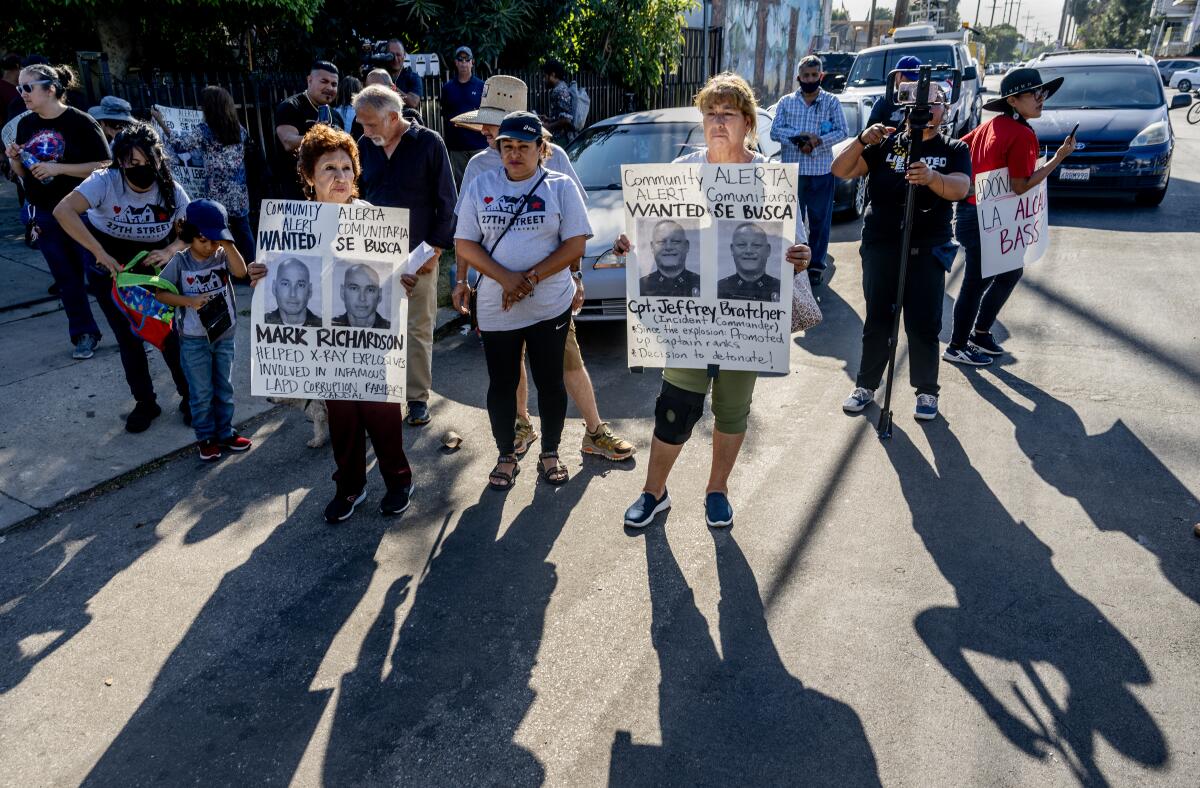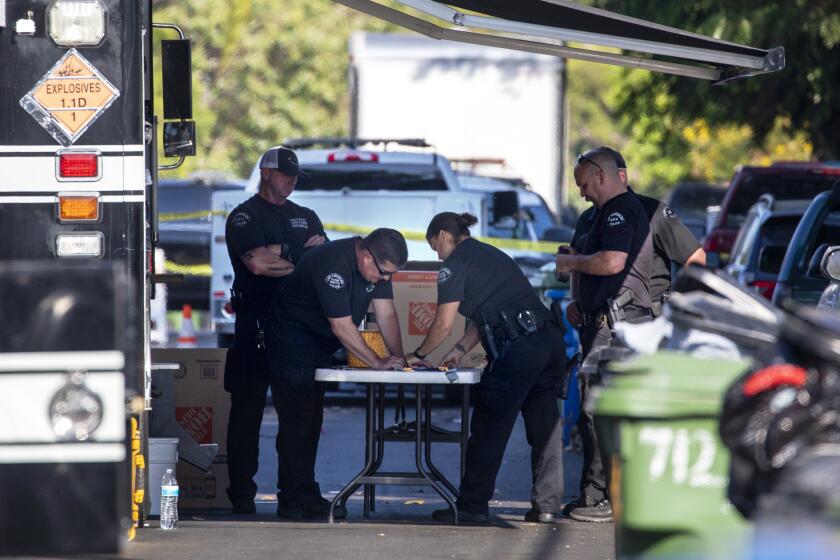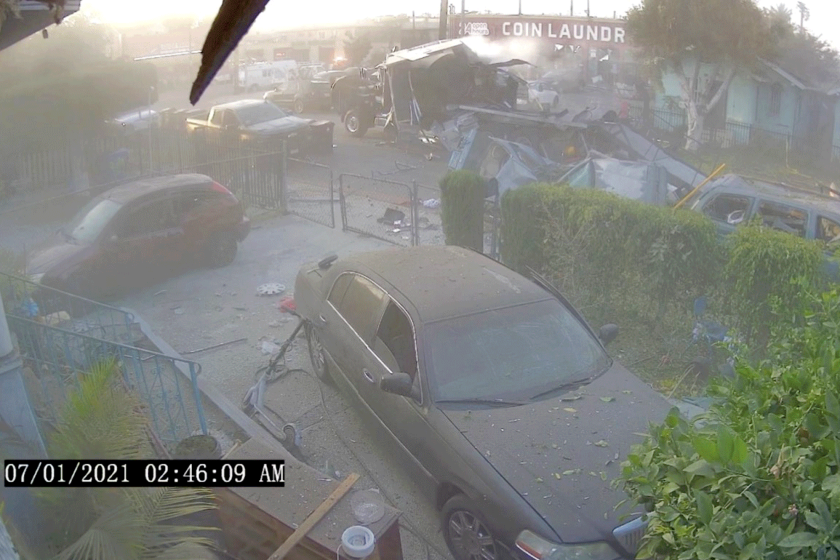Residents displaced by fireworks explosion demand that LAPD officers be fired

- Share via
About 30 people marched in South L.A. on Monday afternoon to demand harsher punishment for the Los Angeles police officers who blew up their neighborhood two years ago.
The march followed a recent Times investigation that, for the first time, named the six bomb squad officers who were involved in the botched detonation of illegal fireworks in June 2021. They were Det. Damien Levesque, Mell Hogg, Mark Richardson, Brendan McCarty, Thomas Deluccia and Stefanie Alcocer.
“It took two freaking years to get the names of officers; that’s a joke,” said Maria Velasquez, who was among more than 80 residents displaced by the blast.
Despite repeated demands from affected residents, the officers’ names and formal discipline in the matter had largely remained veiled, thanks to the LAPD’s secretive disciplinary system and its refusal to discuss personnel matters. The Times was able to determine the officers’ names — and how the LAPD dealt with some of them — through investigative records, court documents and interviews.
The LAPD destroyed much of a South L.A. neighborhood, but would not identify the officers involved. Through investigative records, court documents and interviews, The Times was able to figure them out.
Four officers tied to the incident have been disciplined, according to the LAPD. The only disciplinary action they’ve disclosed is Alcocer’s 10-day suspension, although they did not name her.
The LAPD has cited state law as the reason the department cannot disclose officer personnel records or information relating to the June 2021 explosion. The Times’ attorney pushed back on that, telling Chief Michel Moore that the state requires such disclosures in instances in which officers badly injure people or there are sustained findings of unreasonable or excessive force, as was the case in the blast.
“The Department believes such an interpretation is not supported by the law, because the accidental fireworks explosion was not a ‘use of force,’” Moore said in a statement on Friday evening.
The blast injured at least 17 people and damaged or destroyed 13 businesses, 22 residential properties and 37 vehicles, police have said.
Along with input collected by The Times from local residents, a report by the LAPD’s inspector general helps paint a picture of how guesswork and a laissez-faire management style led to what it calls a “catastrophic failure.”
On Monday, residents gathered along East 27th Street, the site of the detonation, holding signs that read, “The LAPD only serves and protects themselves” and “The criminal police were promoted and their salaries increased.”
The Times reported that Alcocer took a 10-day suspension but also was later promoted to sergeant. Others who were in command that day have also moved up the ranks.
David Kowalski, a commander who oversaw the bomb unit at the time of the incident, was later elevated to deputy chief. Capt. Jeffrey Bratcher, the incident commander, has swiftly risen up the captain ranks.
“For some reason, police officers can do this and not only get away with it, but get promotions,” said Ron Gochez, a community organizer with Unión del Barrio who has helped organize residents. “These police officers need to be fired immediately.”

Organizers assembled signs with photos of several of the officers who were involved in the blast, along with their salaries. That included Kowalski and Bratcher.
Notably missing from the posters were McCarty, a seasoned tech who warned his fellow technicians and his supervisor, Levesque, that the plan wasn’t safe, and Deluccia, who appeared to play a limited role that day, according to the LAPD inspector general’s report.
Residents and organizers marched nearly a mile from boarded-up homes on 27th Street to the Newton Divison station, carrying bottles of water to help with the heat. As they marched, the group chanted, “Justice, yes. Police, no.”
Along the way, the marchers paused for a few minutes at the corner of Central Avenue and Adams Boulevard, where they continued their call-and-response chants as traffic cruised past. Every so often, a motorist would honk a horn in solidarity.
At one point, Gochez pointed toward an LAPD motorcycle officer who was waiting on the light to change.
“Hey, there’s a cop right there. Maybe he’s the one who blew up the neighborhood,” he said as the officer rode away.
The group then swung south onto Central and marched the half a mile or so toward the Newton Division station, walking past curious shop owners, who came outside to see what the commotion was about.
Gochez referred to Newton by its old, unsavory nickname, “Shootin’ Newton.”
Among the group was Juana Oceguera, whose family had been displaced. She expressed anger over the fact that officers were promoted when some residents along the street had lost work after the blast.
“We have to suffer the consequences, and they’re fine,” said Oceguera, as she held a poster with Kowalski’s face. “They’re benefiting from their salaries and we’re battling every day. We lost our homes, our jobs and our tranquility.”
More to Read
Sign up for Essential California
The most important California stories and recommendations in your inbox every morning.
You may occasionally receive promotional content from the Los Angeles Times.

















